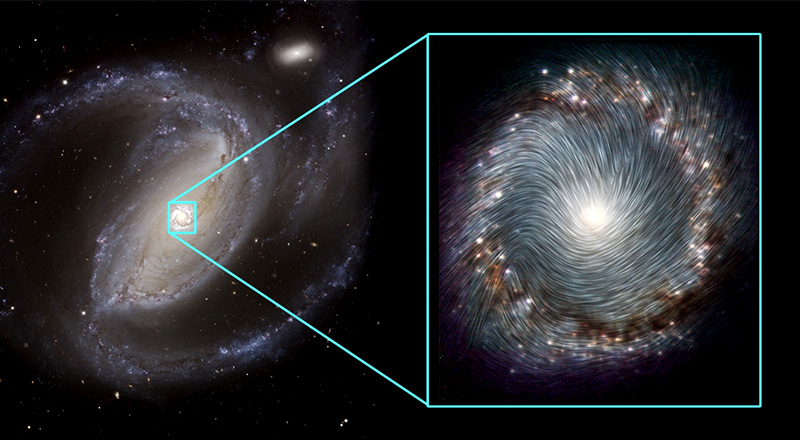Astronomers have imaged the magnetic field along which gas flows to a galaxy’s central black hole.

NGC 1097: ESO; color scale: Prieto et al.
Using visible, ultraviolet, and infrared light, we can make out the stars, gas, and dust that shape galaxies. However, the polarization of that light helps us discern an almost invisible ingredient: the weak magnetic field that permeates the space between stars and shapes galactic evolution.
Stars don't make polarized light themselves — their light waves oscillate every which way. But when starlight interacts with dust grains in space, it can become polarized, vibrating only in particular ways. Since dust grains twist to align with ambient magnetic fields, the polarization pattern of light scattered off the grains reflects the direction of those fields.
Magnetic fields may be subtle in space, but they can impact everything from star formation to the feeding habits of galaxies' central supermassive black holes.
Enrique Lopez-Rodriguez (Stanford University) and colleagues have obtained multiple polarimetric observations of the galaxy NGC 1097, which lies about 45 million light-years away in the constellation Fornax, the Furnace. The galaxy is a barred spiral with a ring of prolific star formation in its center. The researchers used both infrared polarimetry from the airborne Stratospheric Observatory for Infrared Astronomy (SOFIA), which traces the magnetic fields in regions dense with gas, as well as archival radio data, which traces sparser regions.
The results, published in the Astrophysical Journal, show that the magnetic field lines spiral in from the sparse outskirts to the dense ring of dust and gas where stars are forming, and past it as well to the galaxy's very center. Gas follows the magnetic fields, so the lines traced out in the animation below are also showing the path gas takes within the galaxy. The observations provide evidence that it's not just gravity guiding the inward motion but the magnetic field, too.

Lopez-Rodriguez et al.
Ultimately, some of that gas will fall into the supermassive black hole seated at the very center, powering winds and other powerful modes of feedback that are thought to eventually kill the galaxy's star formation.
 0
0









Comments
You must be logged in to post a comment.